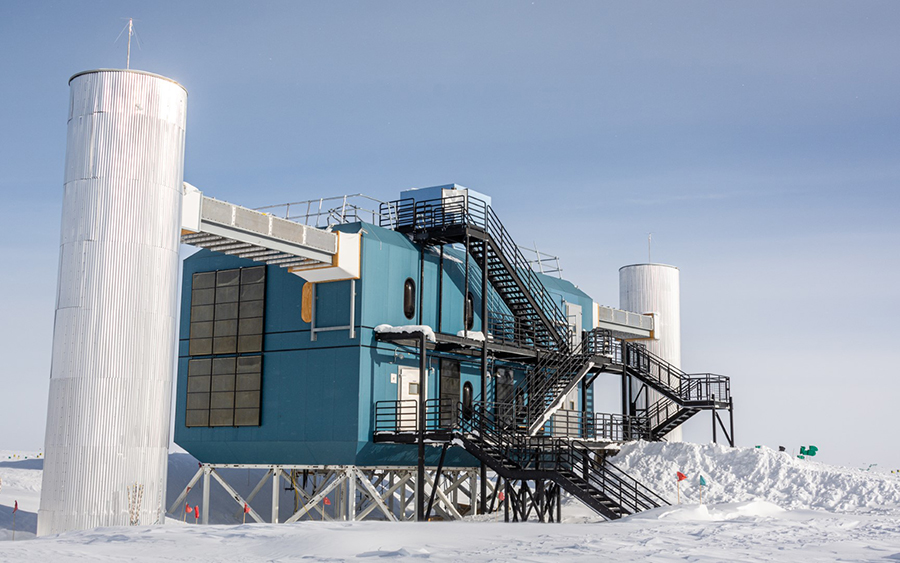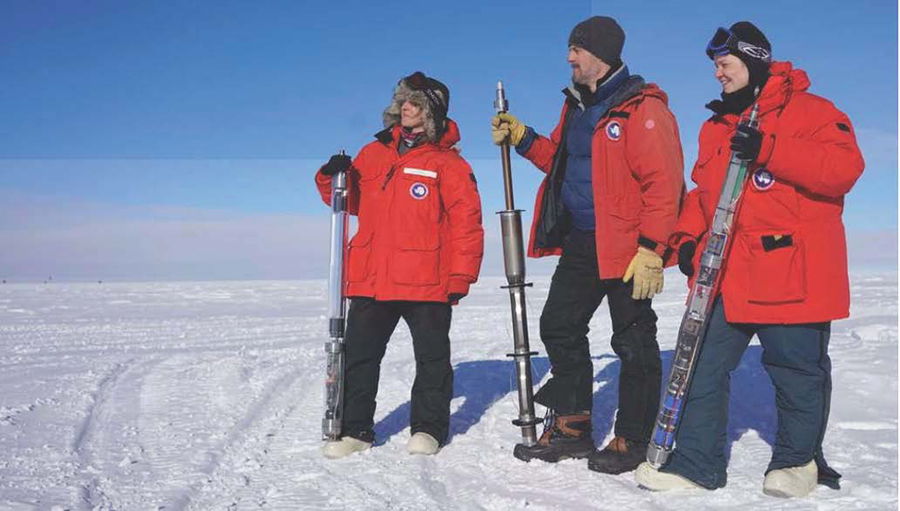Stringing Together More Neutrino DetectorsThe South Pole's Biggest Experiment Gets an UpgradePosted April 27, 2020
The biggest experiment at the South Pole is getting a significant upgrade. 
Photo Credit: Mike Lucibella
Kael Hanson (right), John Hardin and Stephen Sclafani take a close look at fiber optic cables at the IceCube facility in preparation for the observatory's upcoming upgrades.
Over the next three years, IceCube, the neutrino detector located at the South Pole, will be getting numerous new detectors added to its core. It's the biggest upgrade to the IceCube detector since its completion in 2010. "The IceCube upgrade is a project that aims at drilling and installing more strings inside IceCube at the very center," said Delia Tosi, an astrophysicist at the University of Wisconsin, Madison. The additional seven sensor strings should increase the detector’s sensitivity, giving physicists a better chance to understand some of the unusual properties of neutrinos. In addition, new equipment should dramatically clarify data that’s already been collected over the last decade and will help shape any future upgrades to the project. Related Story
The project is supported by the National Science Foundation, which manages the U.S. Antarctic Program. Ghostly ParticlesIceCube detects high-energy neutrinos, ghost-like fundamental particles that are notoriously difficult to observe. Neutrinos are nearly massless particles that travel through the universe at almost the speed of light. Because they're so light, they're also fiendishly difficult to detect. Hundreds of billions of them are passing through every square inch of every surface on planet Earth each second, but they barely register any effect. One of the only ways to detect them is when one just happens to line up perfectly with the nucleus of an atom, smacking into it straight on. The collision releases energy as a small, fast flash of blue light, called Cherenkov radiation. 
Photo Credit: Mike Lucibella
Delia Tosi (left) and Barbara Birrittella inspect one of the buildings used for drilling. Part of the preparations for the upgrades is cataloguing and assessing the condition of the equipment used to construct IceCube originally and see how much is still in good enough shape to reuse.
IceCube is using the South Pole's clear ice as a critical part of the detector by looking for the telltale blue flicker of a neutrino striking the nucleus of a water molecule more than a mile below the surface. Scientists have buried a lattice of more than 5,000 light detectors known as Digital Optical Modules, or DOMs, arranged on 86 long strings like pearl necklaces. Deep in the dark ice, any light the detectors pick up must be created by these particle collisions. Scientists then can reconstruct the neutrino's original path and energy based on the brightness and direction of the flash. Scientists are interested in high energy neutrinos in part because they can open a new way to study the cosmos. Neutrinos are neutrally charged particles, meaning that interstellar magnetic fields can't affect their paths as they fly through space. This way, neutrinos always point directly back to their origin and offer scientists a new way to do astronomy. In addition, there's a great deal about neutrinos themselves that scientists still don't fully understand. Of all the known fundamental particles and forces that make up the Standard Model of physics, there are still a lot of unanswered questions about neutrinos. "Neutrinos are among the standard model particles that are the least well known," said Kael Hanson, a physicist at the University of Wisconsin, Madison, and the IceCube Director of Operations. "They're pretty hard to study because they interact so weakly, so this is kind of the last frontier." Seeing in the DarkScientists are going back to the central core of IceCube and adding to it, upgrading its capability by inserting seven new strings of detectors to it to try to catch more neutrinos in action. "The upgrade is not so much an extension but an infill where we're seeking to put more of the instrumentation in the center of the detector and make it much denser," Hanson said. "Its only seven strings but each of those strings packs almost two times the number of sensors." 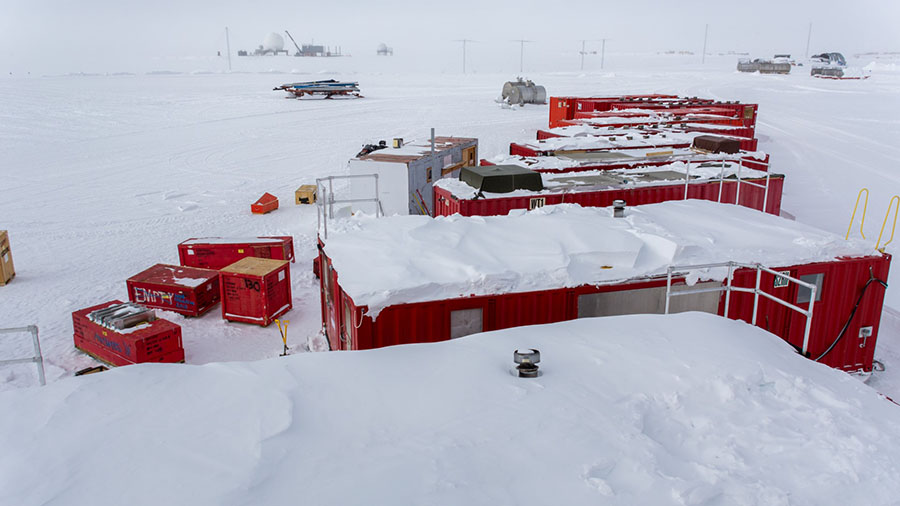
Photo Credit: Mike Lucibella
Shipping containers containing equipment ranging from electrical generators, hot water heaters and other tools have been stored at Amundsen-Scott South Pole station since the completion of IceCube in 2010.
It's a significant upgrade. Though designs are still being finalized, the new strings will hold about 100 detectors along their length, as opposed to 60 in the original IceCube. The layout of the strings themselves will be denser as well, with each string spaced about 20 meters apart from each other, rather than IceCube’s original 125-meter spacing. "We have a large group of people now doing all the possible combinations to see how we can maximize the science that we can get out of these seven holes," Tosi said. The sensors on these new strings will use the latest optical sensor technology, making each much more sensitive than the existing detectors which were originally designed and manufactured in the early 2000s. "Each of those sensors is probably at least a factor of two more photo-area than IceCube DOMs," Hanson said. "Even though [the upgrade] is only seven strings, it actually probably more represents like a 25 or 30 percent enhancement to the total photodetector coverage." 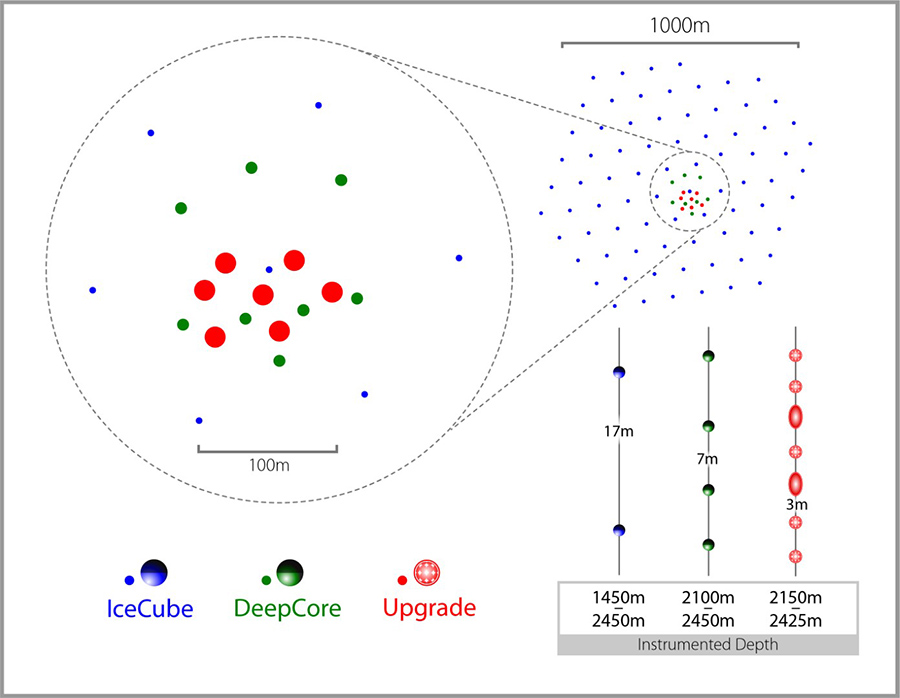
Photo Credit: IceCube-Gen2 Collaboration
IceCube’s strings of sensors, indicated on this map in blue, are spread out over a square kilometer. The footprint of the IceCube Upgrade, indicated in red, will take up just a small fraction of that, but spaced much closer together.
All these upgrades will work together to do a number of things. The dense layout of the numerous new sensors will allow IceCube to pick up weaker flashes of Cherenkov radiation and detect lower energy neutrinos. With this they hope to help answer a question about the fundamental nature of neutrinos by looking at ones that didn't originate from deep in the cosmos, but ones produced by atmospheric particle collisions on the far side of the planet. "The flagship science that we want to do with the upgrade is to actually study the neutrino particle properties," Hanson said. "We'll use the stream of neutrinos that's actually coming from cosmic rays striking the atmosphere on the other side of the Earth. Those produce neutrinos that go through the Earth." One of the curious characteristics of neutrinos is that there are three known kinds, or "flavors," and that they change from one to another as they fly through space. It's a quantum mechanical process called oscillation, and trying to characterize how long it takes for one to turn into another is a major area of fundamental physics research. IceCube can help because the planet itself sets up a handy experiment. Neutrinos are so weakly interacting that the vast majority pass straight through the Earth without being blocked at all. However, a small but important percentage of them will have the dumb luck of smacking into a nucleus within IceCube, lighting up the detectors, and letting scientists characterize it. By comparing the types of neutrinos, they know are produced by atmospheric collisions with what they see in IceCube, scientists can help determine the distance it takes for a neutrino to oscillate, and what factors affect that transformation. "We know what the stream [of neutrinos] is composed of on the other side of the Earth. Mainly muon [neutrinos] with some electron [neutrinos] in there, and no tau neutrinos," Hanson said. "If we know there are zero tau neutrinos on the other side of the Earth, what we can do is we can measure the number of tau neutrino events that we see on this side of the detector, and we can basically say 'How many of those muon neutrinos versus their energy versus the distance that they traveled, changed into tau neutrinos?'" New Life to Old DataIn addition to the new detectors, the team will add new calibration equipment to help improve its existing set of data by better characterizing the optical properties of the ice itself. "Our understanding of the ice fifteen years ago was nowhere near what it is right now," Hanson said. "[The ice] kind of sets the floor for systematic errors for reconstruction; how well we can do reconstruction. We realize right now, that if we had known what we know now about the ice 15 years ago, we probably would have put additional calibration instrumentation in IceCube way back then. We didn't do it, but we get a second chance." 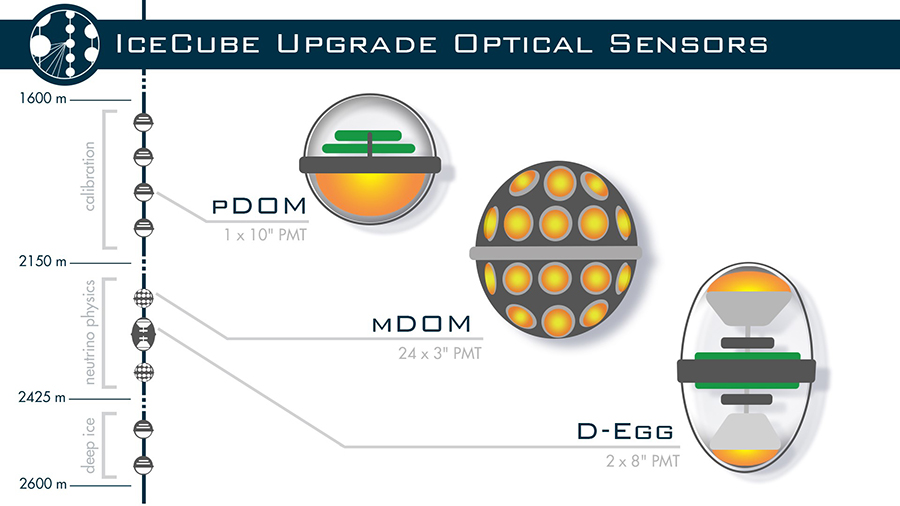
Photo Credit: IceCube Collaboration
Newly designed optical sensors using the latest technology will be installed for the upgrade to IceCube to significantly increase its sensitivity.
The new strings will include light pulsers, essentially bright camera flashes that the researchers will use to calibrate the light-detection equipment of both the existing IceCube and its upgrade. It'll help them better understand how light travels through the ice. Once they've been installed and run a few times, it should not only improve the data of any future neutrino detection, but also every neutrino event that IceCube has ever recorded. "When we get these better calibration constants in 2023 or 2024, all we have to do is reprocess the 15 years of data that's on disc, and we'll be able to release the revised data. It’s like a patch," Hanson said. "The neutrino events will have better energy information and better angular resolution. It'll be like a quantum jump in terms of the data quality that's coming out of IceCube right now." Installing the seven new strings at the core of the existing detector is a major undertaking. Just like when the original 86 strings were installed, the IceCube collaboration will need a dedicated team of drillers and a specially-designed hot water drill to melt out seven mile-and-a-half deep holes to suspend their detectors at the bottom of. The team has already started working by returning to the NSF’s Amundsen-Scott South Pole Station and evaluating the equipment left over from the initial installation. They hope to reuse as much of the original drill and other equipment as possible, so members of the team spent the last two austral summers sorting through what's still usable and what's not. "The drill equipment has been stored since 2011," Tosi said. "One of our goals was to come out here and inspect it and make sure that the important elements are still in place and that they're still in good shape. That is needed now because we're reviewing our budget and so we want to make sure that the preliminary numbers that we estimated to be the cost for the upgrade are still realistic." The plan is to spend next year refurbishing the drill and getting everything working. In the 2021-2022 season, they hope to do some initial tests and bore down through the top layer of compacted snow, known as the firn. 
Photo Credit: Mike Lucibella
With IceCube’s optical modules buried deep below the ice, there’s not much to see at the surface. Clusters of flags mark where the strings of optical modules are located.
"And then in 2022-2023 that's the fun season; deep drilling and deployment, all in one season," Hanson said. The upgrade is also serving as a test bed for the next generation of neutrino detectors that scientists hope someday to use for IceCube Gen2, a proposed, massive expansion to the current detector. "We'll drop in probably a dozen or two dozen prototype modules of different varieties to test the technologies," Hanson said. "But those would just be prototypes. If they totally up and fail, that doesn't compromise the upgrade dimension." Designed to detect the very highest energy neutrinos, Gen2 would be an order of magnitude larger than IceCube's one cubic kilometer of instrumented ice. Though such a major upgrade is still on the drawing board, efforts to develop these next-generation detectors have been ongoing for some time and researchers plan on field testing them along with the upgrade. "Drilling is such a high potential barrier; you want to try to get as much done when you have the holes available as you can," Hanson said. NSF-funded research in this story: Kael Hanson, University of Wisconsin, Madison, Award No. 1719277; Francis Halzen, University of Wisconsin, Madison, Award No. 1600823. |
"News about the USAP, the Ice, and the People"



For USAP Participants |
For The Public |
For Researchers and EducatorsContact UsU.S. National Science FoundationOffice of Polar Programs Geosciences Directorate 2415 Eisenhower Avenue, Suite W7100 Alexandria, VA 22314 Sign up for the NSF Office of Polar Programs newsletter and events. Feedback Form |

